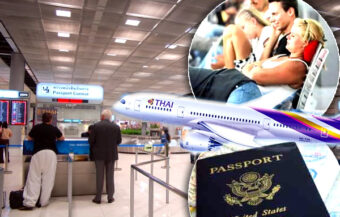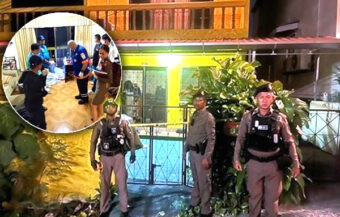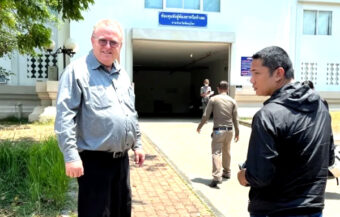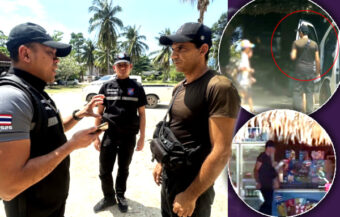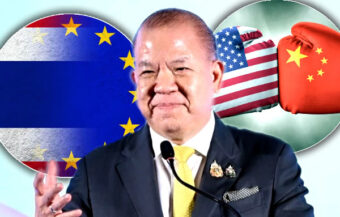On Tuesday, the Information and Investment ministries in Nay Pyi Taw put forward a cross border trading scheme for use by Thai firms using the Thai baht as a settlement currency. The economic initiative is seen as another move, supported by China on a regional basis, to weaken the strength of the US dollar. It comes as the forces of the Tatmadaw, Myanmar’s feared military, are also believed to have launched a Summer offensive against rebel forces in the war-torn country armed with guns, missiles and aircraft supplied by Russia and China with Beijing using Pakistan as a conduit to supply weaponry to the heavily sanctioned junta.
As Thailand faces testing questions concerning its ongoing response to the war in Ukraine and its evolving fallout, another war is raging behind the kingdom’s western border with Myanmar in a bitter struggle between the population of the country and its hated armed forces, the Tatmadaw. One credible source suggests at least 12,000 people have died up to February 1st while there is also new information that both Russia and China are involved in supplying the embattled regime with advanced arms and economic support. This week, an experienced US humanitarian organisation leader described the fighting in Myanmar’s Kayah state near Mae Hong Son province as quite unlike anything he has ever seen in the country before and labelled it as the worst fighting seen there since World War Two.
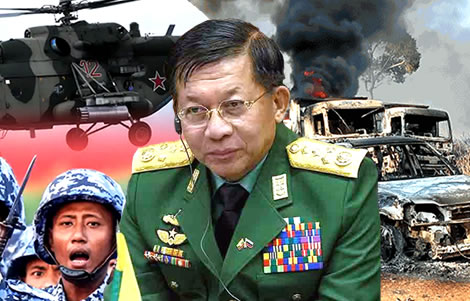
The world is watching the horror of the war in Ukraine unfold with the increasingly worrying possibility of a wider conflict.
On Monday, US national security adviser Jake Sullivan held a seven-hour meeting in Rome with Chinese diplomat Yang Jiechi as the Biden administration which has rattled China with its severe and robust response to the Russian Invasion of Ukraine, made it clear that it will not brook ambiguous but tacit support for Russia’s action from Beijing without taking steps to also chastise the communist country.
Dangerous US Chinese tensions as another all-out, deadly war rages beyond Thailand’s western border
The heightened US Chinese tensions come as another all-out war rages in Myanmar where one respected non-profit organisation monitoring violence in the country from a wide array of sources, has estimated that at least 12,000 people have died since protests against the country’s February 1st coup last year morphed into an all-out civil war with a mobilised population, particularly among the youth of the country since August 2021.
It is understood that the military in Myanmar has recently been supplied with arms and equipment including aircraft, missiles and vehicles from Russia and indirectly from China via Pakistan.
This has allowed the military junta to step up its offensive against both the People’s Defence Force, the national military movement aligned with the exiled National Unity Government and ethnic rebel armies.
Unity Government claims to be the legitimate authority in Myanmar based on the last election poll before the military quashed the democratic process
The unity government was formed from among politicians and elected representatives from the 8th November 2020 General Election in Myanmar which saw the ruling party win a landslide victory consequently triggering a coup less than 3 months later.
Analysts suggest that the military junta in Nay Pyi Taw, led by strong man General Min Aung Hlaing, is trying to take advantage of the drier Summer conditions to break the back of the growing alliance against his forces which have seen defections since the coup last year and low morale among his forces.
There is a hitherto unseen and widespread level of determination among the population in Thailand’s neighbouring country to overthrow the yoke of the Tatmadaw, the state’s feared military which stepped in during the early hours of February 1st to quash the nation’s emerging and popular democratic process.
This began in 2011 leading to the 2015 election which installed Aung San Suu Kyi and her National League for Democracy as Myanmar’s government bringing an end to nearly five decades of military rule since 1962 and threatening the entrenched economic privileges of the military elite.
Warfare in Myanmar not seen since World War Two
On Tuesday, the American director of humanitarian relief organisation, the Free Burma Rangers, Dave Eubank, was reported by the AP newswire describing the fighting he has seen in Kayah State or what was formerly known as Karenni State on the border with Thailand’s Mae Hong Son province, in the northwest of the kingdom, as something he has not witnessed before in his long relationship with Myanmar which goes back decades.
Mr Eubank is a military veteran with a background as a US Army Special Forces and Ranger officer.
He said he believed it was unlike anything seen there since World War Two in Myanmar when the country, then a British colony, found itself occupied by and fighting Japanese forces.
Reports from Myanmar since January 2022 paint a deteriorating security situation as Nay Pyi Taw tries to crush the uprising with reports of ‘war crimes’
His observations are similar to reports that have been emerging from Myanmar since January this year suggesting a rising level of military activity and warfare as the military junta struggles to stay in control of the country against a populace committed to its overthrow.
‘What I saw in Karenni I had not seen in Burma before,’ he told the Associated Press. ‘Airstrikes, not like one or two a day like they do in Karen State, but like two MiGs coming one after the other, these Yak fighters, it was one after the other,’ said Eubank. ‘Hind helicopter gunships, these Russian planes, and then just brought hundreds of rounds of 120mm mortar. Just boom, boom, boom, boom.’
In the same report, referring to drone footage showing an attack on Karenni population centres from artillery bombardment combined with airstrikes, something acknowledged by the military in Myanmar in its own reports, a researcher with Human Rights Watch described what he saw as ‘war crimes’ being perpetrated by the armed forces of the Myanmar junta on the civilian population.
‘These are war crimes,’ Manny Maung explained. ‘These attacks by the military on civilians, civilian buildings, killings of civilians, public buildings like religious buildings, yes, they are no less than war crimes that are happening right now in that particular area and this is because they are indiscriminately targeting civilians.’
Myanmar pushes currency swap trade initiative with Thailand on Tuesday aimed to eliminate the US dollar
Meanwhile, in another parallel with the conflict in Ukraine, the Myanmar Ministry of Information and Investment, on Tuesday, announced that it was allowing the use of the Thai baht as a settlement currency for cross border trade in an arrangement where registered merchants along the war-torn country’s border with the kingdom will be allowed to trade based on a daily announced kyat-baht exchange rate set by Myanmar’s central bank.
Significantly, the Kyat has only lost approximately 9.5% against the Thai baht since the coup in February last year while at the same time, it dropped by 24.3% to the US dollar.
This suggests some diverging dynamic between the currencies as the US has imposed sanctions on the Burmese military junta and its regime but nothing like the swingeing measures taken against Russia over Ukraine.
In the meantime, the World Bank, which predicted that Myanmar, in the fiscal year to the end of September 2021, had lost 18% of its GDP is now projecting a minuscule recovery of 1% up to the 30th September 2022.
Myanmar blames the drop in value of the kyat on ‘economic sabotage’ efforts to hinder its economy
This was alluded to by authorities in Myanmar as they made the trade announcement during which officials described the drop in the value of the kyat as being ‘stoked by economic sabotage’.
The Ministries of Investment and Information in Nay Pyi Taw described the new trade facility being presented to Thailand as one which will reduce ‘dependence on the US dollar’.
It said it aimed to ‘mitigate the risk of sudden exchange rate swings due to external geopolitical factors.’
Myanmar officials described ongoing sanctions by the United States and western allies as an attempt to undermine the stability of the country’s banking and financial system.
The move towards Thailand comes after an earlier overture towards China which is Myanmar’s largest trade partner when it comes both to exports and imports.
Thailand is Myanmar’s second-largest export market and its third-largest import source.
China promotes a shift to regional currencies
Thailand’s trade with Myanmar for the year 2020/2021 was estimated to be worth $5.3 billion.
Burmese authorities have already designated China’s renminbi as a settlement currency in a move that analysts believe is being orchestrated by China as part of a wider policy in the region as it attempts to weaken the influence of the US dollar and America’s economic power which has been deployed with devastating effect against Russia after it invaded Ukraine.
Russian military vehicles unloaded in Yangon in January, Myanmar uses Russian aircraft, firepower
Meanwhile, the strength of the military offensive being launched against Myanmar’s National Unity Government’s People’s Defence Force (PDF) and seasoned troops from among armed ethnic groups is raising concern about just how Myanmar’s military is managing to evade US and western sanctions imposed in the aftermath of the 2021 military coup.
A BBC report quoted an open-source investigation by a group called Myanmar Witness in early February which suggested that Russian armed vehicles were offloaded in Yangon in January while it has long been known that Russia was providing military support to the junta.
However, with Russia now bogged down in its floundering invasion of Ukraine, there are credible reports of increasing cooperation between Pakistan and Myanmar despite the rift between the two countries over the Rohingya crisis.
Arms and military hardware supply route to Myanmar armed forces via Pakistan supported by China
In February, it was reported by the Indian Times that a senior military delegation from Myanmar had visited Pakistan in advance of the dispatch of heavy-duty mortars, grenade launchers and machine guns to the country.
The same source also pointed to the growing use of Pakistan by China as a conduit for military sales and service to Myanmar with deeper military cooperation between the two countries being fostered.
The source pointed to the involvement of Aye Ne Win, the grandson of Myanmar’s former military dictator and strongman General Ne Win in these moves which may extend to JF-17 fighter aircraft purchases and air to surface missiles.
The JF-17 aircraft or Thunder fighter is a multi-role combat plane developed jointly by Pakistan and China with an agreement between China’s Chengdu Aircraft Industries Corporation and PAC or the Pakistan Aeronautical Complex.
This is one of Pakistan’s top defence contractors producing aircraft headquartered in Punjab State.
China in a no-win situation as support for the Nay Pyi Taw regime falls further even within the military
All this is occurring as China is facing a no-win situation in Myanmar much the same as it is facing in Ukraine with its tacit alliance with Russia as part of a mutual assistance pact signed with Vladimir Putin on February 7th last.
Thailand votes on the right side of history in UN deploring Russian military action in Ukraine
Support for the Tatmadaw in the country is waning with some estimates suggesting that up to 10,000 military personnel and policemen have already defected to the National Unity Government.
Formerly regarded as one of the world’s largest active duty fighting forces, the Tatmadaw was estimated to have 370,000 to 400,000 fighters. Thailand, by comparison, has just over 360,000 active-duty military personnel.
However, Myanmar’s fighting force is currently thought to have been reduced to just over 100,000 active fighters as the military’s recruitment efforts have been impeded by the destabilisation of the country and those taking flight from its ranks.
UN Human Rights Chief is more pessimistic and sees the outcome as being similar to that seen in Syria
The mobilisation of the population against government forces was confirmed last month when the UN Human Rights Chief for Myanmar, Michelle Bachelet said: ‘Many have gone into these militias or created these so-called peoples’ defence forces. So that’s why for a long time, I’ve been saying that, if we’re not able to do something more strongly about it, it will echo so much the Syria situation.’
The extent to which Myanmar is now a country at war was confirmed in the same report from the BBC prepared by conflict monitoring group Acled (Armed Conflict Location and Event Data Project).
It has reported coordinated and disciplined resistance to Myanmar’s military across the country which is particularly notable in areas or among populations such as the Bamar people, where such resistance against the military has not been seen before.
The organisation has also confirmed that this armed resistance has now reached urban centres in Burma.
In particular, the latest data underlines that the conflict has grown in intensity with more casualties being reported after August 2021 and a rising death toll which up to February 2022 had already reached 12,000 people dead with more lives being lost in direct combat activity with the Tatmadaw as opposed to protest activity or civilian massacres.
Chinese interests and population in Myanmar are targets in this conflict as they were seen to be linked to military repression even before the coup
Since the uprising began early last year, Chinese interests in Myanmar have been targeted because of a widespread perception among the population that it is interwoven with the junta regime and that Beijing initially supported the coup against the democratic government, at the outset, last year.
However, there is a long-standing Chinese population in Myanmar who have been active in mercantile and professional life in the country.
Many Burmese people of Chinese descent have long found themselves as targets of public animosity even before the 2021 coup. This hostility is linked to the advancement of Chinese commercial interests in the country, often linked with joint ventures between state or military firms and Chinese investors who have ready access to capital.
For instance, in 2014, at Letpadaung copper mine in the south of the Sagaing Region in central Myanmar, violence broke out over a joint venture between the Myanmar military and a Chinese state-owned firm which led to land being taken from locals, something which was violently opposed by the majority of the population.
‘Chinese workers are strangers,’ said U Myint Thein, a resident from the town of Monywa. ‘They don’t know our local customs. So we feel they are arrogant.’
Chinese mines among the targets of the People’s Defence Force controlled by the exiled unity regime
Last year, in the aftermath of the coup and public revulsion at it, 2,000 miners in the area joined protests and civil disobedience activities.
That was only the start, the mines in Sagaing Region were, later in the year, among the first key targets of the People’s Defence Force when it began to conduct offensive operations.
It blew up electricity pylons leading to the facilities in the first openly documented acts of its military campaign against the junta under the control and on behalf of the National Unity government.
China set its position in stone when it described the coup of February 1st 2021 as a ‘cabinet reshuffle’
The initial reaction by Beijing to the February 1st coup not only inflamed public animosity in Myanmar towards the communist regime in China but also set an irreversible course when it described the democratic government’s overthrow as a ‘cabinet reshuffle’.
There was also talk of the junta enlisting the help of China in controlling the internet in the same ways as we have seen some moves made recently in Cambodia and indeed in Thailand for more state control over online content and the news narrative accessed by the public.
Minister signals a move to resurrect a national internet gateway and stronger online controls
This situation escalated dramatically after the protests against the coup turned violent and resulted in loss of life when elite units of the army used live ammunition on street demonstrators.
Threat to Thailand from the encroaching dragon of the North as Chinese factories in Myanmar burn
This saw Chinese factories being targeted and destroyed by fire as mobs rampaged in Yangon and other areas.
This prompted a bristling response from Beijing that ‘drastic action’ was being considered if authorities in Myanmar failed to bring the situation under control.
New ambiguous course by canny Chinese diplomats who are calling for a resumption of democracy
The shifting dynamics in Myanmar has led canny Chinese diplomats to open up channels of communications between both sides of the conflict at this point.
In particular, China has recognised the unique position of the National League for Democracy, the political party of Aung San Suu Kyi as representing the views of Burmese people.
In June 2021, Chinese Foreign Minister, Wang Yi, while meeting the junta’s Foreign Minister U Wunna Maung Lwin in China, stressed Beijing’s support for the resumption of democratic institutions in Myanmar.
However, the ambiguous nature of China’s position is much the same as in Ukraine.
It has underpinned its support for the military junta despite a violent public uprising as it aims to support efforts to stabilise the country economically.
Junta pushes forward with China’s economic projects
This has led to greater advancement of Chinese projects in Burma under the Belt and Road initiative which includes a freight corridor linking Yangon to Chengdu.
These efforts also include the continued development of the China-Myanmar Economic Corridor linking Yunnan in Southwestern China and Mandalay as well as the town of Kyaukpyu in western Myanmar.
This development received strong support from Aung San Suu Kyi and the democratic government at a time when Myanmar welcomed inward investment and in particular at a time when the now-deposed democratic leader was facing western censure for her failure to intervene in the Rohingya crisis and allegations of genocide by Burmese armed forces.
Isolated coup regime dependent on China and links with neighbouring countries such as Thailand, opposed in ASEAN by countries like Singapore
The isolated junta regime in Myanmar has become very much dependent on China much the same as Putin’s Russia as it fights a bitter and bloody internal war.
Meanwhile, within ASEAN, there have been attempts to pull Nay Pyi Taw in from the cold with Cambodia’s prime minister and strong man Hun Sen visiting the country in January.
It is thought that China is behind such moves while Myanmar’s junta is thought to be receiving indirect support from Laos, Thailand and Cambodia.
Any moves to accommodate the junta have been successfully and more strongly resisted by other ASEAN nations, particularly Singapore which along with Indonesia has backed a strong stance in excluding the junta from summits of the organisation.
Singapore is the largest investor in Myanmar making its position in support of the rule of law even more principled.
Singapore has also emerged as a vociferous opponent of the Russian invasion of Ukraine imposing tough economic and financial sanctions against Moscow on the basis that the small city-state must uphold the rights of smaller nations under the UN charter.
ASEAN has become dysfunctional in a crisis
The Ukraine war has further polarised positions within the dysfunctional regional organisation when it comes to dealing with international crises.
UK Foreign Secretary visits Bangkok after AUKUS security pact further raises tensions with China
This is disturbing as ASEAN may well find itself at the centre of the next international crisis if China ever decides that the moment is opportune to invade Taiwan or blockade the independent, self-governing island it claims sovereignty over, has vowed to take back and which US intelligence sources suggest is a distinct contingency in the next five to ten years or even at any time going forward.
Join the Thai News forum, follow Thai Examiner on Facebook here
Receive all our stories as they come out on Telegram here
Follow Thai Examiner here
Further reading:
Thailand calls for Myanmar talks as besieged coup leader is barred from the ASEAN summit in Brunei
FM Don to attend Myanmar ASEAN summit with high stakes for Thailand as civil war there looms large
Crisis in Myanmar threatens to escalate as Thai authorities monitor the situation on a daily basis
Threat to Thailand from the encroaching dragon of the North as Chinese factories in Myanmar burn
Coup boss writes to Prayut for support as UK man with Chinese partner flees troubled Myanmar
Australian arrested in Myanmar as coup takes on significance for US Chinese rivalry in the region



